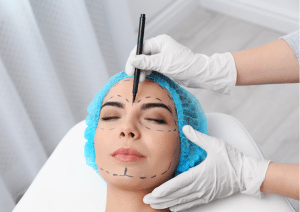Background
The deep plane facelift, also known as the composite facelift, is a surgical technique designed to rejuvenate the facial and neck regions by targeting multiple layers beneath the skin. Unlike traditional methods primarily focused on skin tightening, the composite facelift targets muscle, fat, and connective tissue for a comprehensive rejuvenation of the face and neck.

Composite facelift
History
In the 1970s and the 1980s surgeons who favoured natural look, introduced a novel facelift technique named SMAS and which was specifically designed to lift and reposition deeper tissue layers. This was far better than what other surgeons used to do which included use of body fat which only lasted short time and provided insufficient facial contour. The SMAS composite facelift combines the procedures of the SMAS facelift and fat volume grafting. Consequently, treated areas look fresher and natural-looking; the aim is to achieve a more comprehensive facial rejuvenation.
Indications
Significant Facial Sagging: In case these are your main concerns that caused the sagging on your midface, jaws and neck, a composite facelifting can tackle all these problems effectively.
Loss of Facial Volume: As people age, they usually discover that they gradually lose fat and collagen in their faces, making them look hallow or concave. Edge rejuvenation provides some of the lost volume through its deeper tissue positioning.
Contraindications
Allergies and Sensitivities: Individuals with allergies or sensitivities to anesthesia or surgical materials, including medications used during the procedure, may not be suitable candidates.
Medical Conditions: Certain medical conditions may preclude patients from undergoing surgery due to heightened procedural risks. Examples of such conditions include hypertension, bleeding disorders, and cardiac issues.
Thin or Fragile Skin: Usually, thinned, or weak-skinned patients are not considered ideal candidates for facelift surgery as it is somehow the type of the operation that involves the manipulation and repositioning of skin and deeper layers of tissue.
Outcomes
Equipment
Equipment
Surgical Instruments
Anesthesia Equipment
Facial Markers
Facial Implants or Fillers
Sutures and Closure Materials
Facial Nerve Monitoring Devices
Facial Drains
Postoperative Dressings and Bandages
Patient preparation:
Consultation: The main objective of the first meeting is the doctor appraising your goals, your medical history, and drugs that you can be taking.
They as well do a comprehensive physical examination of your face and neck, involving taking photographs too.
Medical Evaluation: It is essential to obtain clearance from your primary care physician to confirm your suitability for undergoing invasive procedures.
Medication Adjustment: You may receive guidance to discontinue blood-thinning medications, such as aspirin or anticoagulants, several weeks before your surgical procedure.
Dietary Instructions: Detailed dietary recommendations for the days leading up to your surgery.
Patient position:
The preferred position is supine.
Technique for composite facelift
Step 1: Pre-operative Planning and consultation:
They will do an initial examination and investigate your goals, and look on your facial anatomy, and then determine whether the composite technique will be appropriate. Photography dealing with face, and even body might be used to compare the present look to the expressions you made when you last got it.

Composite facelift planning
Step 2: Anesthesia:
Like the normal facelift, you will also receive general anesthesia or local anesthesia along with sedation for numbing in the area.
Step 3: Incision:
The incision pattern, which you can often associate with the conventional facelift, they seem to start at the temples, naturally follow the earlobe and end at the lower scalp. At times, an incision is performed as well as the chin extending underneath.
Step 4: Deep Tissue Dissection:
The surgeon meticulously dissects to elevate a composite flap containing:
Orbicularis oculi muscle (around the eyes)
Platysma muscle (in the neck and lower face)
Malar fat pad (responsible for cheek volume)
Step 5: Repositioning and Redraping:
The surgeon carefully repositions the composite flap to achieve:
Loosened and uplifted folds on the jaw and neck muscles.
Correction of problems such as ptosis (hanging down) caused by the malar fat pad may also be part of this treatment.
Correction of the lower eyelid flaws through restoration of the tissue surrounding the muscles: the orbicularis oculi.
Step 6: Closure and Recovery:
With the incisions being stitched up or sealed using adhesives.
Bandages are applied to start with to provide early brace and inflammation control.
Your progress in recovery will be checked before your discharge undergone with the detailed specific instructions for you post operation.
Step 7: Post-operative care:
The patient is then brought out of anesthesia, and its vital signs are carefully observed during the recovery phase. They are given out in detail post-surgery care instruction that include how to relieve the pain, inhibit swelling and edema and take care of the incision sites which will lead to healing properly.
Laboratory tests
CBC: Complete blood count is must, to check for variation in RBC, as well as the hemoglobin and the hematocrit levels.
BMP: (Basic metabolic panel) analysis is done to see the kidney function, liver function, and electrolyte levels.
Complications
Infection: A composite facelift carries the same risk of infection as any surgical operation. Significant redness, swelling, discomfort, and fever are possible signs of infection.
Scarring: One typical response to the healing process is scarring. While other cases may develop hypertrophic scars (raised, red scars) or keloid scars (thick, lumpy scars).
Unnatural appearance: Composite facelift, in its turn, can have some undesirable results, for instance – pulled-face effect or concentration of volume in parts of the face which is not normal.

The deep plane facelift, also known as the composite facelift, is a surgical technique designed to rejuvenate the facial and neck regions by targeting multiple layers beneath the skin. Unlike traditional methods primarily focused on skin tightening, the composite facelift targets muscle, fat, and connective tissue for a comprehensive rejuvenation of the face and neck.

Composite facelift
History
In the 1970s and the 1980s surgeons who favoured natural look, introduced a novel facelift technique named SMAS and which was specifically designed to lift and reposition deeper tissue layers. This was far better than what other surgeons used to do which included use of body fat which only lasted short time and provided insufficient facial contour. The SMAS composite facelift combines the procedures of the SMAS facelift and fat volume grafting. Consequently, treated areas look fresher and natural-looking; the aim is to achieve a more comprehensive facial rejuvenation.
Significant Facial Sagging: In case these are your main concerns that caused the sagging on your midface, jaws and neck, a composite facelifting can tackle all these problems effectively.
Loss of Facial Volume: As people age, they usually discover that they gradually lose fat and collagen in their faces, making them look hallow or concave. Edge rejuvenation provides some of the lost volume through its deeper tissue positioning.
Allergies and Sensitivities: Individuals with allergies or sensitivities to anesthesia or surgical materials, including medications used during the procedure, may not be suitable candidates.
Medical Conditions: Certain medical conditions may preclude patients from undergoing surgery due to heightened procedural risks. Examples of such conditions include hypertension, bleeding disorders, and cardiac issues.
Thin or Fragile Skin: Usually, thinned, or weak-skinned patients are not considered ideal candidates for facelift surgery as it is somehow the type of the operation that involves the manipulation and repositioning of skin and deeper layers of tissue.
Equipment
Surgical Instruments
Anesthesia Equipment
Facial Markers
Facial Implants or Fillers
Sutures and Closure Materials
Facial Nerve Monitoring Devices
Facial Drains
Postoperative Dressings and Bandages
Patient preparation:
Consultation: The main objective of the first meeting is the doctor appraising your goals, your medical history, and drugs that you can be taking.
They as well do a comprehensive physical examination of your face and neck, involving taking photographs too.
Medical Evaluation: It is essential to obtain clearance from your primary care physician to confirm your suitability for undergoing invasive procedures.
Medication Adjustment: You may receive guidance to discontinue blood-thinning medications, such as aspirin or anticoagulants, several weeks before your surgical procedure.
Dietary Instructions: Detailed dietary recommendations for the days leading up to your surgery.
Patient position:
The preferred position is supine.
Step 1: Pre-operative Planning and consultation:
They will do an initial examination and investigate your goals, and look on your facial anatomy, and then determine whether the composite technique will be appropriate. Photography dealing with face, and even body might be used to compare the present look to the expressions you made when you last got it.

Composite facelift planning
Step 2: Anesthesia:
Like the normal facelift, you will also receive general anesthesia or local anesthesia along with sedation for numbing in the area.
Step 3: Incision:
The incision pattern, which you can often associate with the conventional facelift, they seem to start at the temples, naturally follow the earlobe and end at the lower scalp. At times, an incision is performed as well as the chin extending underneath.
Step 4: Deep Tissue Dissection:
The surgeon meticulously dissects to elevate a composite flap containing:
Orbicularis oculi muscle (around the eyes)
Platysma muscle (in the neck and lower face)
Malar fat pad (responsible for cheek volume)
Step 5: Repositioning and Redraping:
The surgeon carefully repositions the composite flap to achieve:
Loosened and uplifted folds on the jaw and neck muscles.
Correction of problems such as ptosis (hanging down) caused by the malar fat pad may also be part of this treatment.
Correction of the lower eyelid flaws through restoration of the tissue surrounding the muscles: the orbicularis oculi.
Step 6: Closure and Recovery:
With the incisions being stitched up or sealed using adhesives.
Bandages are applied to start with to provide early brace and inflammation control.
Your progress in recovery will be checked before your discharge undergone with the detailed specific instructions for you post operation.
Step 7: Post-operative care:
The patient is then brought out of anesthesia, and its vital signs are carefully observed during the recovery phase. They are given out in detail post-surgery care instruction that include how to relieve the pain, inhibit swelling and edema and take care of the incision sites which will lead to healing properly.
CBC: Complete blood count is must, to check for variation in RBC, as well as the hemoglobin and the hematocrit levels.
BMP: (Basic metabolic panel) analysis is done to see the kidney function, liver function, and electrolyte levels.
Infection: A composite facelift carries the same risk of infection as any surgical operation. Significant redness, swelling, discomfort, and fever are possible signs of infection.
Scarring: One typical response to the healing process is scarring. While other cases may develop hypertrophic scars (raised, red scars) or keloid scars (thick, lumpy scars).
Unnatural appearance: Composite facelift, in its turn, can have some undesirable results, for instance – pulled-face effect or concentration of volume in parts of the face which is not normal.

Both our subscription plans include Free CME/CPD AMA PRA Category 1 credits.

On course completion, you will receive a full-sized presentation quality digital certificate.
A dynamic medical simulation platform designed to train healthcare professionals and students to effectively run code situations through an immersive hands-on experience in a live, interactive 3D environment.

When you have your licenses, certificates and CMEs in one place, it's easier to track your career growth. You can easily share these with hospitals as well, using your medtigo app.



